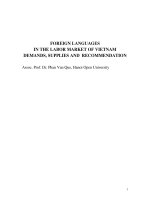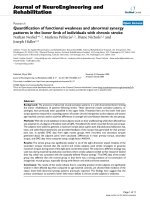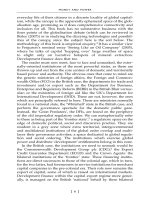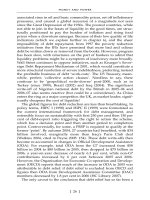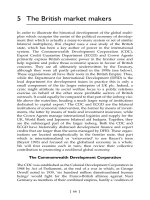DISPOSITIONS ON SANITARY AND PHYTOSANITARY (SPS) MEASURES IN THE NEW GENERATION OF FREE TRADE AGREEMENTS OF VIETNAM
Bạn đang xem bản rút gọn của tài liệu. Xem và tải ngay bản đầy đủ của tài liệu tại đây (590.58 KB, 124 trang )
MINISTRY OF EDUCATION AND TRAINING
FOREIGN TRADE UNIVERSITY
MASTER THESIS
DISPOSITIONS ON SANITARY AND
PHYTOSANITARY (SPS) MEASURES
IN THE NEW GENERATION OF
FREE TRADE AGREEMENTS OF VIETNAM
Specialization: International Trade Policy and Law
FULL NAME: LE NGOC TRAM
Hanoi – 2019
MINISTRY OF EDUCATION AND TRAINING
FOREIGN TRADE UNIVERSITY
MASTER THESIS
DISPOSITIONS ON SANITARY AND
PHYTOSANITARY (SPS) MEASURES
IN THE NEW GENERATION OF
FREE TRADE AGREEMENTS OF VIETNAM
Major: International Economics
Specialization: International Trade Policy and Law
Code: 8310106
Full name: Le Ngoc Tram
Supervisor: Dr. Nguyen Ngoc Ha
Hanoi - 2019
STATEMENT OF ORIGINAL AUTHORSHIP
I hereby declare that this master thesis is my own scientific research which is
made under the guidance of my supervisor, Dr. Nguyen Ngoc Ha. The contents and
results of this research are completely honest. The information, data and documents
which are collected from various sources for analysis and evaluation have been
fully cited in the main content and in the references list of this master thesis as well.
Student,
Le Ngoc Tram
CONTENTS
ACKNOWLEDGEMENTS.....................................................................................i
LIST OF TABLES...................................................................................................ii
LIST OF ABRREVIATIONS................................................................................iii
ABSTRACT.............................................................................................................v
INTRODUCTION...................................................................................................1
1. Research rationale..............................................................................................1
2. Literature review................................................................................................2
2.1. Analysis of new generation free trade agreements and SPS measures within
the framework of WTO.......................................................................................2
2.2. SPS measures in the context of free trade agreements and dispositions of
SPS measures in the new generation free trade agreements of Vietnam.............4
2.3. Vietnam’s legislation in compliance with SPS commitments in NGFTAs...6
3. Research objectives............................................................................................8
4. Research questions.............................................................................................8
5. Scope of research...............................................................................................9
6. Research methodology.......................................................................................9
7. Structure of thesis.............................................................................................10
CHAPTER 1: OVERVIEW OF SPS PROVISIONS IN THE NEW
GENERATION FREE TRADE AGREEMENTS...............................................11
1.1. Overview of new generation free trade agreements.......................................11
1.1.1. Definition of new generation free trade agreements................................11
1.1.2. Legal basis of new generation free trade agreements..............................12
1.1.3. Characteristics of new generation free trade agreements........................13
1.1.4. Roles of new generation free trade agreements.......................................16
1.1.5. New generation free trade agreements of Vietnam..................................19
1.2. Legal basis of SPS provisions in the new generation free trade agreements. 24
1.2.1. SPS Agreement in WTO.........................................................................24
1.2.2. Legal basis of SPS measures in the new generation free trade agreements
.......................................................................................................................... 35
1.2.3. Criteria to assess Vietnam’s legislation on SPS measures.......................36
CHAPTER 2: DISPOSITIONS ON SPS MEASURES IN THE NEW
GENERATION FREE TRADE AGREEMENTS OF VIETNAM.....................38
2.1. A confirmation of WTO’s SPS obligations....................................................40
2.1.1. Definitions, rights and obligations..........................................................40
2.1.2. Special and differential treatment............................................................41
2.1.3. Dispute settlement in accordance with WTO’s provisions......................41
2.2. Supplements beyond WTO’s SPS obligations...............................................43
2.2.1. Equivalence.............................................................................................43
2.2.2. Risk assessment......................................................................................45
2.2.3. Regionalized concept..............................................................................46
2.2.4. Transparency, competent authorities and contact points.........................48
2.2.5. Dispute settlement beyond WTO’s obligations.......................................51
2.2.6. SPS Committee.......................................................................................52
2.2.7. Emergency measures...............................................................................53
2.2.8. Cooperation.............................................................................................54
2.2.9. Control, inspection and approval procedural specifics............................57
2.2.10. Tobacco control measures and Halal requirements...............................62
2.3. General evaluations on SPS measures in the new generation free trade
agreements...........................................................................................................63
2.3.1. Having broader scope.............................................................................63
2.3.2. Being more specific and comprehensive.................................................64
2.3.3. Containing more specific procedures......................................................65
2.3.4. Enhancing the transparency....................................................................66
CHAPTER
3: VIETNAM’S
SPS
MEASURES
LEGISLATION AND
RECOMMENDATIONS FOR VIETNAM IN THE IMPLEMENTATION OF
SPS
PROVISIONS
IN
ITS
NEW
GENERATION
FREE
TRADE
AGREEMENTS.....................................................................................................67
3.1. SPS measures legal framework of Vietnam...................................................67
3.1.1. Overview of Vietnam’s SPS measures legislation...................................67
3.1.2. Sources of SPS measures legislation in Vietnam....................................71
3.2. The compatibility of Vietnam’s legal framework with its new generation free
trade agreements’ SPS commitments...................................................................74
3.2.1. New generation free trade agreements’ commitments that Vietnam’s
legislation is compatible...................................................................................74
3.2.2. New generation free trade agreements’ commitments that Vietnam’s
legislation has not been compatible with..........................................................82
3.3. Effects of SPS measures in the new generation free trade agreements’ on
Vietnam’s legislation............................................................................................88
3.4. Recommendations for Vietnam in the implementation of SPS dispositions in
the new generation free trade agreements............................................................89
3.4.1. Improving provisions in Vietnam’s legislation in accordance with
regulations of new generation free trade agreements........................................89
3.4.2. Raising awareness of SPS measures in the new generation free trade
agreements........................................................................................................95
3.4.3. Taking advantage of cooperation and technical support in SPS measures
.......................................................................................................................... 96
CONCLUSION......................................................................................................97
LIST OF REFERENCES......................................................................................99
1
ACKNOWLEDGEMENTS
In order to complete this master thesis, I have been received enthusiastic
guidance and support from my lectures, family and friends. From the bottom of my
heart, I would like to express my thanks to them.
Firstly, I would like to express the sincerest thanks to my supervisor, Dr.
Nguyen Ngoc Ha who has supported, guided and encouraged me during the
completion of this master thesis from choosing the topic, outlining the main ideas,
turning those ideas into this thesis to editing this paper. Without his enthusiastic and
excellent guidance and support, I could not have completed this master thesis.
Also, I would like to express my special thanks to all lectures of the Master of
International Policy and Law program, Foreign Trade University as well as World
Trade Institute who gave me the chance to broaden my humble horizon in the field
of economics and laws.
Last but not least, I would like to express my warm thanks to my family, my
colleagues and my friends who never stop supporting, encouraging and giving me
the favorable conditions to complete this master thesis.
2
LIST OF TABL
Table 2.1: A confirmation of WTO's obligations.....................................................38
Table 2.2: Supplements beyond WTO’s SPS obligations......................................39Y
Table 3.1: Vietnamese legal documents regulating SPS measures...........................71
3
LIST OF ABRREVIATIONS
Abbreviatio
Full name
n
APEC
ASEAN
CODEX
CPTPP
Asia – Pacific Economic Cooperation
Association of South East Asian Nations
Codex Alimentarius Commission
Comprehensive and Progressive Trans – Pacific Partnership
CSR
CTC
DSU
EAEUFTA
EU
EVFTA
FAO
FTA
GATS
GATT
IICA
IPPC
MFN
NGFTA
NT
OIE
PTA
SPS
STDF
TPP
VKFTA
WTO
Agreement
Corporate social responsibility
Cooperative Technical Consultation
Dispute Settlement Understanding
Vietnam – the Eurasian Economic Union FTA
European Union
EU – Vietnam Free Trade Agreement
Food and Agriculture Organization
Free Trade Agreement
General Agreement on Trade in Services
General Agreement on Tariffs and Trade
Inter – American Institute for Cooperation on Agriculture
International Plant Protection Convention
Most Favored Nation
New generation Free Trade Agreement
National Treatment
Organization for Animal health
Preferential Trade Agreement
Sanitary and Phytosanitary
Standards and Trade Development Facility
Trans – Pacific Partnership Agreement
Vietnam – Korea Free Trade Agreement
World Trade Organization
4
ABSTRACT
New generation FTA is an inevitable tendency for members to deeply
cooperate in a variety of areas, including SPS measures. Joining NGFTAs, Vietnam
is not out of that tendency, therefore, Vietnam has to fully comply with
commitments regulated in NGFTAs. With topic “Dispositions on Sanitary and
Phytosanitary (SPS) measures in the new generation of Free Trade Agreements of
Vietnam”, the thesis focuses on similarities and differences on regulations between
SPS Agreement (WTO) and NGFTAs of Vietnam in order to point out the
dispositions on SPS measures. Not limited to this, the thesis analyzes Vietnam’s
legal documents on SPS measures compared to regulations stated in NGFTAs.
Following that, the thesis mainly focuses on several issues and gains some
achievements as below. Firstly, the thesis comprehensively analyzes regulations on
SPS measures in SPS Agreement (WTO) and NGFTAs of Vietnam. As a result, the
similarities and differences between them are stated. Based on that, the thesis
reveals that NGFTAs of Vietnam not only reconfirm regulations on SPS measures
of SPS Agreement, but also have supplementary regulations.
Secondly, the thesis details Vietnam’s legal documents on SPS measures in
order to state the compatibility and not compatibility of legal documents on SPS
measures compared to NGFTAs of Vietnam. Each provision on SPS measures is
analyzed so as to point out for which provisions Vietnam’s legislation fully
complies and for which provisions Vietnam’s legislation party and not complies.
Thirdly, based on analysis above, recommendations for Vietnam to fully
comply with regulations on SPS measures when joining NGFTAs are revealed.
Besides complying with regulations stated in NGFTAs, recommendations for
Vietnam to take advantage of NGFTAs are also pointed out.
1
INTRODUCTION
1. Research rationale
In the context of globalization, countries have a tendency to extensively and
comprehensively cooperate in a variety of areas, therefore, the number new
generation free trade agreements (NGFTAs) has increased significantly and
gradually replaced traditional free trade agreements (FTAs). NGFTAs focus on new
issues such as labor, sustainable development and the environment which are not
mentioned in traditional FTAs.
Vietnam has joined sixteen FTAs1, including several typical NGFTAs, for
example, the Comprehensive and Progressive Trans – Pacific Partnership
Agreement (CPTPP), Vietnam – EU FTA (EVFTA), Vietnam – Korea FTA
(VKFTA) and Vietnam – the Eurasian Economic Union FTA (EAEUFTA)2. Being
different from traditional FTAs, NGFTAs have broad scope of commitments and
strict requirements3 on areas such as environment, sustainable development and
human, animal or plant life or health besides economic growth.
As for area related to human, animal or plant life or health, compared to SPS
Agreement (WTO), NGFTAs contain strict requirements and requirements which
are beyond regulations of SPS Agreement, for example, import requirements and
procedures, verifications, audits and inspections, procedure for listing of
establishments, certification and documents confirming safety, and regulations on
tobacco control measures and halal products. Besides, Vietnam has potential on
production and exportation of agricultural and aquatic products which are
significantly affected by regulations on SPS measures when Vietnam ratified
NGFTAs. In order to increase exportation of agricultural and aquatic products to its
1 WTO Center, Tổng hợp các FTA của Việt Nam tính đến tháng 11/2018 (Summary of FTAs of Vietnam until
November, 2018), 2018b, at < accessed on 29th Oct 2018.
2 Le Thi Thuy, “Hiệp định thương mại tự do thế hệ mới: Cơ hội và thách thức đối với Việt Nam” (New
generation FTAs: opportunities and challenges for Vietnam), Journal on science and society of Vietnam,
Vol.5 (114), 2016, p.19.
3 Ibid., p.19 – 20
2
partners’ market in NGFTAs, and take advantages of NGFTAs, Vietnam has to
comply with strict regulations on SPS measures in NGFTAs.
The number of NGFTAs which Vietnam has joined and ratified has increased
since the year 20154, but most legal documents related to SPS measures were issued
before that point of time. As a result, there is a gap between regulations on SPS
measures in NGFTAs of Vietnam and Vietnam’s legislation of that area. In order to
effectively take advantage of opportunities brought by NGFTAs and comply with
commitments on SPS measures regulated in NGFTAs that Vietnam officially signed
and has implemented, Vietnam’s legal framework on SPS measures should be
amended and improved.
For the reasons mentioned above, the topic “Dispositions on Sanitary and
Phytosanitary (SPS) measures in the new generation of Free Trade Agreements
of Vietnam” is chosen to reveal the disposition of SPS measures in NGFTAs of
Vietnam compared to those of WTO. Also, the gap of regulations on SPS measures
between NGFTAs of Vietnam and Vietnam’s legislation is pointed out. Based on
that analysis, the paper will give some recommendations on Vietnam’s legislation to
fully implement regulations on SPS measures of NGFTAs.
2. Literature review
While there is a huge number of researches being conducted on NGFTAs and
SPS measures in the framework of WTO, not many researches have carried out SPS
measures in NGFTAs, especially, in NGFTAs of Vietnam. This part of the thesis
will analyze several typical researches on NGFTAs and SPS measures in WTO.
2.1. Analysis of new generation free trade agreements and SPS measures within
the framework of WTO
Firstly, concerning NGFTAs, paper “What scope for an EU – ASEAN Free
Trade Agreement”5 is a paper revealing potentials of EU – ASEAN FTA which is
considered a NGFTA through analysis of general characteristics, trade and
4 WTO Center (2018b), op. cit.
5 O’Callaghan and Nicolas, “What scope for an EU – ASEAN Free Trade Agreement”, Journal of World
Trade, Vol.42 (issue 1), 2008, p.105 – 128.
3
investment policies, trade restrictiveness and the correlative relation between two
partners (EU and ASEAN). Based on that, major features of potential EU – ASEAN
FTA which is a NGFTA are stated, for example, behind border measures and
requirements accommodating different capacity level. To conclude, this paper
emphasizes characteristics of NGFTAs such as addressing behind the border issues,
broad scope of commitments and different timelines for different members.
Paper “New generation FTAs: opportunities and challenges for Vietnam” 6
reveals several typical NGFTAs of Vietnam, for instance, EVFTA, CPTPP, VKFTA
and EAEUFTA. Also, characteristics of NGFTAs are analyzed such as broad scope
of commitments, high level of liberalization, institutional commitments and most
participants being developed parties. Then opportunities and challenges to Vietnam
when joining NGFTAs are revealed in this paper.
Paper “Overview of new generation Free Trade Agreement” 7 points out
definition and characteristics of NGFTAs. In addition, legal basis of NGFTAs is
revealed in this paper with several typical NGFTAs of Vietnam such as CPTPP and
EVFTA.
Furthermore, in paper “Role of NGFTAs in international trade”8, comparison
between NGFTAs and traditional FTAs is analyzed. This paper focuses on
characteristics of NGFTAs. Based on the main characteristics of NGFTAs, roles and
effects of NGFTAs are stated. In general, this paper mainly discusses the difference
of NGFTAs compared to traditional FTAs through particular characteristics of
NGFTAs and its roles on one member’s economic and development.
To sum up, there are many researches on NGFTAs which clearly point out
definition, characteristics and roles of NGFTAs. Several papers also carry out
6 Le Thi Thuy (2016), op. cit, p.19 – 29.
7 Nguyen Thanh Tam, “Tổng quan về các FTA thế hệ mới” (Overview of new generation Free Trade
Agreements), Education and Society Online Journal, 2016, at < accessed on 15th Oct 2018.
8 Vu Van Ha, “Vai trò của các hiệp định thương mại tự do thế hệ mới trong thương mại quốc tế” (Roles of
NGFTAs in international trade), Financial Journal, 2017, at < accessed on 20th Oct 2018.
4
typical NGFTAs of Vietnam, for example, CPTPP and EVFTA in order to state
differences of those NGFTAs compared to traditional FTAs.
Secondly, regarding SPS measures in the framework of WTO, as SPS
Agreement (WTO) was issued in the year 2008, there are so many researches on
SPS measures in WTO. This part of the thesis will point out several typical papers
on this issue. Paper “Sanitary and Phytosanitary (SPS) issues”9 clearly focuses on
definition of SPS measures. Also, it carries out SPS Agreement (WTO) and its rules
when SPS measures are applied.
Furthermore, paper of Office of the US Trade Representatives in the year 2014
“2014 Report on Sanitary and Phytosanitary Measures” 10 firstly provides overview
information of SPS measures, including definition of SPS measures, SPS
Agreement (WTO) with its scope and its main provisions, and the reports of
individual member on SPS measures. In detail, definition of SPS measures is laws,
decrees, requirements and regulations that governments apply to protect human,
animal or plant life or health from risks of pests, diseases or toxins. About SPS
Agreement (WTO), this paper points out scope of SPS Agreement and its provisions
which are appropriate level of protection, science – based measures, risk
assessment, harmonization, transparency and SPS Committee.
2.2. SPS measures in the context of free trade agreements and dispositions of SPS
measures in the new generation free trade agreements of Vietnam
FTAs are becoming a vital and important feature in the trading world in order
to further the economic integration, replacing multilateral trade negotiations at
WTO which has slow and unsatisfied process in multilateral trade liberalization.
FTAs regulate not only tariff issues but other non – tariff issues such as SPS
measures. There are few papers which mention SPS measures in the context of
FTAs.
9 European Commission, Sanitary and Phytosanitary (SPS) issues.
10 Office of the US Trade Representatives, 2014 Report on Sanitary and Phytosanitary Measures,
Washington D.C, the USA, 2014.
5
Paper “Role of Sanitary and Phytosanitary measures within the context of
Free Trade Agreement”11 mentions and analyzes definition of SPS measures, two
fundamental principles of WTO in relation to SPS Agreement which are recognition
of equivalent SPS measures to protect human, animal or plant life or health and not
creating discrimination between members with identical and similar conditions.
Based on that, the paper reveals that FTAs improve the concept of SPS national
sovereignty in order to protect human, animal or plant life or health in relation to
international trade between members. It means that SPS measures with higher level
of protections are acceptable if they are based on scientific evidence. Also, SPS
measures in FTAs must be based on the transparency. FTAs require to report other
relevant parties if SPS measures applied have effects on international trade.
Also, paper “Preferential Trade Agreement Policies for Development, Chapter
TBT and SPS measures, in practice”12 conducts SPS measures in the context of
preferential trade agreements (PTAs). In particular, the paper states that members
use PTAs to deal with issues which could not be solved through WTO. This paper
points out that PTAs include SPS provisions, incorporate cooperation on standards,
certification, and conformity assessment issues. Also, PTAs are designed to
contribute to economic integration through the removal of related barriers. Then this
paper carries out SPS chapter of several typical agreements of North – South PTA
and South – South PTA as examples.
In addition, paper “Comparing EU Free Trade Agreements: Sanitary and
Phytosanitary Standards”13 reveals overview information of SPS Agreement,
including principle provisions which are among the main provisions creating
content of SPS Agreement. Based on that analysis, this paper compares individual
provision of NGFTAs of EU (EU – Mexico Global Agreement, EU – Chile
11 Alfonso Torres, “Role of Sanitary and Phytosanitary measures within the context of Free Trade
Agreements”, Rev Colom Cienc Pecua, Vol.26 No.1, 3/2013, p.43 – 47.
12 Andrew L. Stoler, “Preferential Trade Agreement Policies for Development, Chapter TBT and SPS
measures, in practice”, in Jean – Pierre Chauffour and Jean – Christophe Maur, Preferential Trade Agreement
policies for development, World Bank Publication, Washington DC, 2011, p.217 – 233.
13 Bettina Rudloff and Johannes Simons, Comparing EU Free Trade Agreements: Sanitary and
Phytosanitary Standards, University of Bonn, 2004, at < >, accessed on 03rd Dec 2018.
6
Association Agreement and Euro – Mediterranean Association Agreements) with
SPS Agreement in order to state which provisions of NGFTAs of EU confirm WTO
provisions and which provisions of NGFTAs of EU are beyond WTO provisions.
Besides, there are some papers carrying out SPS measures in a few typical
NGFTAs of Vietnam (CPTPP and EVFTA). Concerning CPTPP, paper “Sanitary
and Phytosanitary measures in the context of the CPTPP Agreement”14 mainly
focuses on new points of SPS measures regulated in CPTPP compared to SPS
Agreement (WTO), for example, strengthening communication, consultation and
cooperation between the parties, SPS Committee, transparency, special and
differential treatment, equivalence, regionalization, auditing, and consultation
(Cooperative Technical Consultations).
Paper “SPS measures and the TPP – Removing barriers to agricultural
exports”15 analyzes similarities and differences between provisions in SPS Chapter
of TPP and provisions in SPS Agreement. This paper focuses on provisions
regulating import check, certification, regionalization, science and risk analysis,
audit, and transparency provisions. The main purpose of this paper is to point out
which provisions of TPP reconfirm regulations on SPS Agreement and which
provisions are beyond regulations of SPS Agreement.
Furthermore, there are several papers which generally points out the
similarities and differences on SPS measures between SPS chapter of only two
NGFTAs of Vietnam (CPTPP and EVFTA) and SPS Agreement (WTO). There is no
paper particularly focusing on analyzing SPS measures of four NGFTAs of Vietnam
compared to SPS Agreement (WTO).
2.3. Vietnam’s legislation in compliance with SPS commitments in NGFTAs
Turning into Vietnam’s legislation and its compliance with SPS commitments
of NGFTAs, in book “Vietnam: Seizing the opportunities of new – generation free
14 Sofia Boza, “Sanitary and Phytosanitary measures in the context of the CPTPP Agreement”, Firenze
University Press, Vol.7 (1), 2018, p.87 – 98.
15 Sidley, SPS measures and the TPP – Removing barriers to agricultural exports, 2016.
7
trade agreements”16, chapter “Impact assessment of the TBT and SPS chapters of
TPP and EVFTA” generally points out SPS provisions in TPP and EVFTA different
from SPS Agreement. Then this chapter of the book gives some recommendations
such as consultations with industry associations, government agencies and partners
to promote understanding, and some focus points for reform and compliance efforts
(introducing risk – based import control, encouraging the development of electronic
certificate, laboratory upgrading, promoting international standards). However, this
part does not specifically point out drawbacks of current Vietnam’s legislation
compared to NGFTAs, and detailed recommendations when Vietnam has joined
NGFTAs.
To conclude, there are several points which are not mentioned in the previous
papers. Firstly, papers only focus on general differences between provisions on SPS
measures of several NGFTAs of Vietnam (CPTPP, EVFTA) and those of SPS
Agreement (WTO). It lacks papers which analyze and synthesize all similarities and
differences between provisions on SPS measures of NGFTAs of Vietnam and those
of SPS Agreement (WTO). Secondly, there are papers on SPS measures of two
NGFTAs of Vietnam (CPTPP and EVFTA) only, and there is not any paper
analyzing SPS measures of two other NGFTAs of Vietnam (VKFTA, EAEUFTA).
Thirdly, there is no paper deeply conducting the compliance of Vietnam’s legislation
with SPS provisions regulated by four NGFTAs of Vietnam (CPTPP, EVFTA,
VKFTA and EAEUFTA). Fourthly, it lacks paper on detailed recommendations for
Vietnam in the implementation of SPS dispositions in NGFTAs.
As a result, surplus above mentioned reasons, this paper will solve those
issues. For the first and second issue, all provisions of SPS chapter of four NGFTAs
of Vietnam (CPTPP, EVFTA, VKFTA and EAEUFTA) will be comprehensively
analyzed and compared with not only provisions of SPS Agreement (WTO) but also
with each other in order to point out which provisions are similar to those of WTO
16 Ministry of Industry and Trade of Vietnam, World Bank Group, Vietnam: Seizing the opportunities of new
– generation free trade agreements, Proceedings of a joint event organized by Ministry of Industry and Trade
and the World Bank, 2016, p.99 – 135.
8
and which provisions are beyond regulations of WTO. For the third issue, current
Vietnam’s legislation will be carried out so as to synthesize the level of compliance
of Vietnam’s legislation with SPS commitments in those four NGFTAs. Based on
all analysis above, the fourth issue will be addressed with the detailed
recommendations for Vietnam in the implementation of SPS dispositions in
NGFTAs, including but not limited to recommendations on improving Vietnam’s
legislation in accordance with regulations of NGFTAs.
3. Research objectives
The main objective of this reasearch is to carry out characteristics and roles of
NGFTAs, new regulations on SPS measures of four NGFTAs of Vietnam (CPTPP,
EVFTA, VKFTA and EAEUFTA) by comparing and pointing out similarities and
differences between SPS regulations in those NGFTAs and SPS Agreement (WTO).
Also, Vietnam’s legislation on SPS measures in three areas (human health,
animal health and plant protection and quarantine) is analyzed as a basis to provide
recommendations for amending and improving Vietnam’s legislation related to SPS
measures in order to fully implement commiments on SPS measures in NGFTAs.
4. Research questions
In order to clarify the research objectives above, this research reveals several
research questions:
What are the characteristics of NGFTAs?
What are the roles of NGFTAs?
What is the legal basis of SPS provisions in NGFTAs?
What are the similarities and differencies between SPS regulations of SPS
Agreement (WTO) and four typical NGFTAs of Vietnam (CPTPP, EVFTA,
VKFTA and EAEUFTA)?
How do new regulations on SPS measures in those four NGFTAs of Vietnam
affect Vietnam’s legislation?
9
How has Vietnam’s legislation of SPS measures been implemented?
How could Vietnam’s legislation of SPS measures been improved in
accordance with commitments in those four NGFTAs?
5. Scope of research
This thesis will analyze overview information of NGFTAs, but it will analyzed
more detailed about four typical NGFTAs of Vietnam only, they are EU – Vietnam
FTA (EVFTA), Comprehensive and Progressive Agreement for Trans – Pacific
Partnership (CPTPP), Vietnam – Korea FTA (VKFTA) and Vietnam – the Eurasian
Economic Union FTA (EAEUFTA).
In those four NGFTAs of Vietnam, this thesis focuses on SPS measures which
are regulated in SPS chapter of each NGFTA. In particular, it makes a comparison
between regulations on SPS measures in SPS chapter of those four NGFTAs of
Vietnam and regulations on SPS measures of SPS Agreement (WTO) in order to
point out similarities and differences between them.
Furthermore, Vietnam’s legal documents on SPS measures will be carried out
in three fields like human health, animal health, and plant protection and quarantine.
The thesis will point out which provisions on SPS measures of those four NGFTAs
of Vietnam are regulated and which provisions on SPS measures are beyond
regulations of Vietnam’s legislation.
After analyzing all parts above, the thesis will give several recommendations
for Vietnam in the implementation of SPS measures in those NGFTAs of Vietnam.
6. Research methodology
During the research of this thesis, different research methods are applied.
Firstly, method to collect information and data from reference is used. Relevant
textbooks, researches, articles, journals, reports and legal documents (NGFTAs of
Vietnam, SPS Agreement and Vietnamese legal documents on SPS measures) are
analyzed in order to reveal overview of NGFTAs and SPS measures.
10
Secondly, about methods for analyzing data, analysis and synthesis of theory
method is applied. In detail, each provision of SPS Agreement (WTO) and SPS
Chapter in NGFTAs is analyzed in order to reveal their regulations on SPS
measures. Also, regulations on SPS measures of Vietnam’s legal documents are
analyzed to give a deep insight about the regulations of Vietnam’s legislation on
SPS measures. Then, comparison method is applied to clarify the similarities and
differencecs between regulations on SPS measures of SPS Agreement (WTO) and
NGFTAs of Vietnam, and between NGFTAs of Vietnam and Vietnam’s legal
documents. In addition, synthesis method is utilized to point out the dispositions on
SPS measures in NGFTAs of Vietnam and the gap between Vietnam’s legislation on
SPS measures.
Thirdly, synthesis method is also used to carry out the compatiblity and not
compatibility between regulations on SPS measures of NGFTAs of Vietnam and
Vietnam’s legal documents and give several recommendations for Vietnam to fully
comply with commitments in NGFTAs of Vietnam.
7. Structure of thesis
Besides introduction, conclusion and list of references, the thesis consists of
three chapters as follow:
Chapter 1: Overview of SPS measures in the new generation free trade agreements
Chapter 2: Dispositions on SPS measures in the new generation of free trade
agreements of Vietnam
Chapter 3: Vietnam’s SPS measures legislation and recommendations for Vietnam
in the implementation of SPS provisions in its new generation free trade agreements
11
CHAPTER 1: OVERVIEW OF SPS PROVISIONS IN THE NEW
GENERATION FREE TRADE AGREEMENTS
1.1. Overview of new generation free trade agreements
1.1.1. Definition of new generation free trade agreements
About concept of traditional FTAs, the term FTA is firstly shown in General
Agreement on Tariffs and Trade (GATT 1947). In detail, the definition of free trade
area has been revealed that “A free – trade area shall be understood to mean a
group of two or more customs territories in which the duties and other restrictive
regulations of commerce […] are eliminated on substantially all the trade between
the constituent territories in products originating in such territories” 17. Also, GATT
1947 states that “the provisions of this agreement shall not prevent the formation of
a customs union or of a free – trade area or the adoption of an interim agreement
necessary for the formation of a customs union or of a free trade area” 18. In
general, Article XXIV of GATT 1947 only shows the definition of free trade area,
but through that definition, the GATT 1947’s concept about FTAs could be seen as
follows.
Firstly, contracting parties join FTAs to reduce tariff and other trade
regulations. Secondly, the goods originated from contracting parties receive benefits
from tariff and trade regulation reduction. Thirdly, the concept of traditional FTAs is
suitable with the time of GATT 1947 when contracting parties mainly traded with
each other in tangible goods, so that GATT 1947 focuses on trade in goods. To
conclude, the concept of traditional FTAs is mainly about trade in goods. The level
of commitment between parties is about reduction of duty and trade regulations.
Regarding the concept of new generation free trade agreements (NGFTAs),
since 1990s, the concept of traditional FTAs is not suitable with the development of
economic integration. NGFTAs with broad scope of commitments and high level of
liberalization with commitments being beyond the trade in tangible goods gradually
17 See more in GATT 1947, Article XXIV, subparagraph 8b
18 Ibid., paragraph 5
12
replace traditional FTAs19. NGFTAs include not only tariff reduction but also other
issues under GATT/WTO (World Trade Organization) and new issues which are
beyond the WTO’s regulation. Compared to traditional FTAs, NGFTAs cover new
issues like labor, sustainable development and the environment. It also covers some
other issues such as human rights, counter – terrorism and democracy 20.
To sum up, NGFTAs are treaties between contracting parties that agree on not
only tariff reduction but also other issues such as labor, the environment, human
rights and democracy. NGFTAs have broader scope of commitments and higher
level of liberalization than traditional FTAs21.
1.1.2. Legal basis of new generation free trade agreements
In WTO, one of the most important principles is Most Favored Nation (MFN).
It means that WTO members must apply the same condition on all trade with other
WTO members. However, there are some exceptions for this principle and it is the
legal basis of FTAs. According to Article XXIV of GATT, contracting parties are
allowed to create free trade areas or customs unions 22. Following that, contracting
parties could give more trade preferences to other parties in the free trade area or
customs union than other parties. This does not violate MFN principle. Article
XXIV of GATT lets contracting parties not apply MFN rules in some situations.
Firstly, “a customs union shall be understood to mean the substitution of a single
customs territory for two or more customs territories, so that duties and other
restrictive regulations of commerce are eliminated”23. It can be seen that contracting
parties could establish customs union and give preferences on duties and other
regulations for their partners. Secondly, “a free – trade area shall be understood to
mean a group of two or more customs territories in which the duties and other
restrictive regulations of commerce are eliminated […]”24. Thirdly, “any interim
agreement shall include a plan and schedule for the formation of such a customs
19 Nguyen Thanh Tam (2016), op. cit.
20 Vu Van Ha (2017), op. cit.
21 Le Thi Thuy (2016), op. cit., p19 – 20.
22 Nguyen Thanh Tam (2016), op. cit.
23 See more in GATT 1947, Article XXIV, subparagraph 8a
24 Ibid., subparagraph 8b
13
union or of such a free – trade area within a reasonable length of time” 25. It can be
revealed that contracting parties could establish temporary customs union or free
trade area within a reasonable length of time.
Article XXIV of GATT establishes legal basis of free trade area. Contracting
parties could give others in the free trade area more preferences. Although free trade
area is an exception, it has to comply with the following conditions. Firstly, the
duties and other regulations in free trade area do not create more barriers to trade
with the third parties. It means that the establishment of free trade area does not
create more restriction regulations on the third parties than before. Secondly, there
must be regulations on “substantially all the trade between the territories” 26. Thirdly,
free trade area must be established within a reasonable length of time 27. In addition,
for trade in services, General Agreement on Trade in Services (GATS) also states
that “this Agreement shall not prevent any of its Members from being a party or
entering into an agreement liberalizing trade in services […]” 28. It can be seen that
GATS allows members to create FTA on trade in services.
To sum up, firstly, WTO Agreements and FTAs have legal mutual relation.
The regulations in WTO are legal basis to create FTAs. In order words, the content
and main provisions of FTAs are established based on provisions and agreements of
WTO. For example, the chapter “Sanitary and Phytosanitary Measures” in FTAs is
established based on Sanitary and Phytosanitary Agreement of WTO. Secondly, it is
stated that WTO regulations seem not to be sufficient to regulate the growing
international trade and not cover all issues between members, therefore, NGFTAs
are established to cover issues which are beyond WTO.
1.1.3. Characteristics of new generation free trade agreements
With development of international trade, scope of commitments and level of
liberalization of traditional FTAs seem not to be suitable. Therefore, traditional
25 Ibid., subparagraph 5c
26 Ibid., subparagraph 8b
27 Ibid., subparagraph 5
28 See more in GATS, Article V
14
FTAs are gradually replaced by NGFTAs which differ from traditional FTAs in
some characteristics.
1.1.3.1. High level of liberalization
NGFTAs have higher level of liberalization than traditional FTAs. The main
purpose of traditional FTAs is tariff and trade regulations reduction on goods traded,
but tariff and trade regulations reduction is applied for some lines of products only,
while NGFTAs, which have higher level of liberalization, have tariff reduction on
most lines of goods. According to NGFTAs, tariff on about 95 percent of lines of
products is eliminated immediately after FTAs come into force 29. As a result, goods
are more freely and easily traded between members in free trade area.
Also, NGFTAs include trade not only in goods but also in services. Most types
of services in NGFTAs are under commitments between members. It means that
based on NGFTAs, members open up most types of services. In summary, NGFTAs
have higher level of liberalization than traditional FTAs because NGFTAs allow
members to cut down tariff for most lines of goods and open up most types of
services.
1.1.3.2. Broad scope of commitments with strict requirements
The main difference between traditional FTAs and NGFTAs is that NGFTAs
have broad scope of commitments which are not limited by trade in goods.
Compared to traditional FTAs which cover trade in goods and mainly focus on tariff
reduction, NGFTAs mention not only trade in goods but also other areas such as
labor, sustainable development and environment 30. Also, NGFTAs cover some other
issues such as human rights, counter – terrorism and democracy 31.
In the context of globalization, requirements of members about all areas are
higher, especially in subjects like the environment, human health and life and
sustainable development. Therefore, most members pay attention to those areas
29 Vietnamese Logistics Association, Việt Nam trong xu hướng FTA thế hệ mới (Kỳ 1) (Vietnam in the
tendency of new generation FTAs), Vietnam Logistics Review, 2015, at < accessed on 10th Nov 2018.
30 Nguyen Thanh Tam (2016), op. cit.
31 Vu Van Ha (2017), op. cit.
